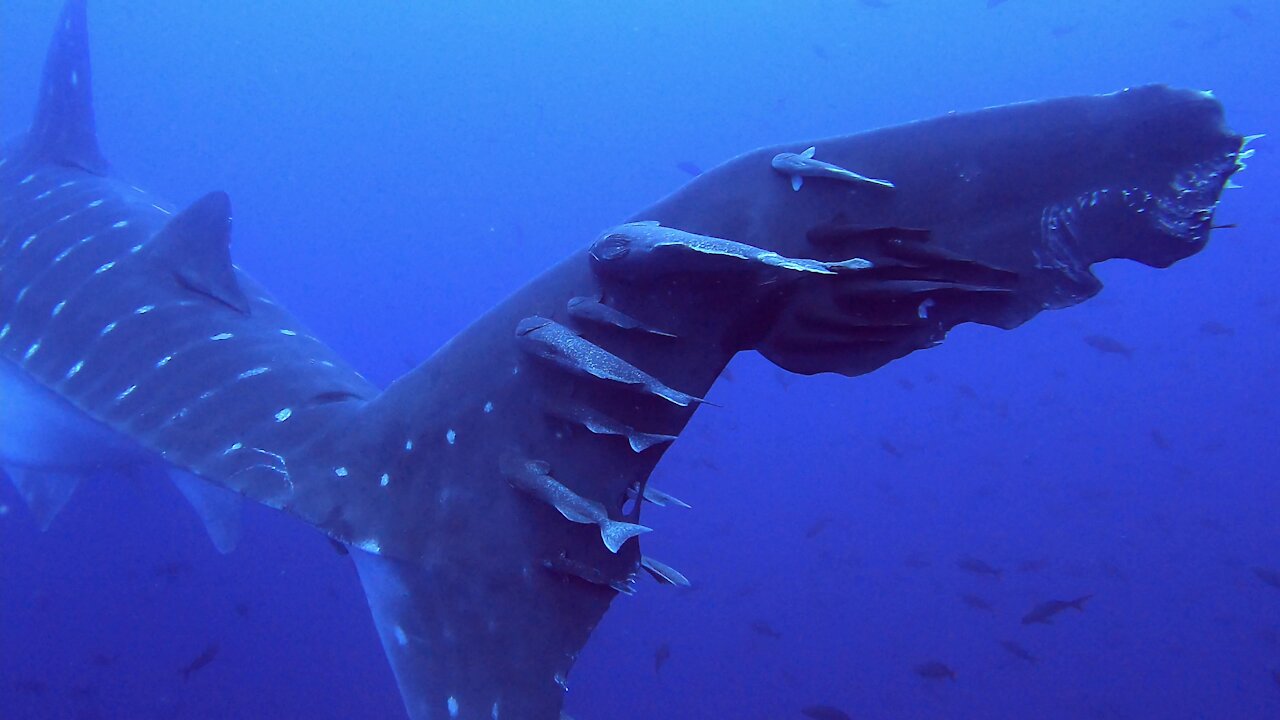Premium Only Content

Researchers find gigantic whale shark with deformed tail
The Galapagos Islands are home to an abundance of life beneath the waves and below. It is a mysterious world, frighteningly harsh and inhospitable in many ways. Yet, the animals have evolved to thrive here despite the extreme challenges they face here.
Called the "Land Born of Fire", the Galapagos Islands are relatively new in Geological terms, having formed 4 million years ago as a result of violent volcanic eruptions from the ocean floor. Lave cooled and hardened, creating pillars that rose above sea level and eventually became islands.
The oceans around the Galapagos are unique due to the convergence of three major ocean currents in one spot. The mix of warmer and colder water creates an ecosystem full of animals and food sources. One of the animals that congregates here is the majestic and enormous whale shark, the largest of all shark species, and the largest fish to have ever lived since the dinosaurs swam these oceans. A few species of whale are larger, but whales are mammals and the whale shark is a fish.
Whale sharks come to the waters around Darwin and Wolf Island in the late July and into November. Researchers and scientists have theories about the reason for their presence here but little is known about these gentle giants. Almost without exception, the whale sharks here are pregnant females. They do not exhibit feeding behaviour, despite the masses of plankton and small fish here that make up the whale sharks' diet. Most experts agree that these waters likely provide the whale sharks with an opportunity to bear their young in relative safety, compared with other areas of the world.
Scientists do not know much about juvenile whale sharks and the babies are rarely seen anywhere in the oceans around the globe. These scuba divers have come to capture images that will help them identify the sharks by individual spots and markings. They will document behaviour and estimate sizes to compile date that answers questions about their migration and reasons for traveling such great distances to be here in the Galapagos.
This whale shark has a unique deformity on its tail. It appears to have a mishapen section on the upper portion of the tail that extends beyond the profile of a normal whale shark's tail. It is possible that the tail has an injury and that the cartilage has been affected, but the upper portion of the tail has elongated skin at the rear, suggesting abnormal and asymmetrical growth.
There is a lot to be learned about these giants of the deep. They are magnificent and beautiful, and for many scuba divers, seeing a whale shark up close is the most magical experience possible. Dwarfing a human, they can grow to almost 19m (55 feet) in length. When full grown, they are as enormous as a school bus. Having one swim past within arm's reach, as these researchers have experienced is unforgettable.
-
 2:11
2:11
WildCreatures
1 month ago $1.34 earnedBrilliant Blue Hyacinth Macaw Eats Nuts With Impressive Dexterity
17.2K16 -

Chicks On The Right
3 hours agoComey's FAFO moment, Dallas sniper details, DFWYF, and who to trust in media.
2.18K3 -
 LIVE
LIVE
Welcome to the Rebellion Podcast
17 hours agoYou Made it to FriJay - WTTR Podcast Live 9/26
315 watching -
 1:29:14
1:29:14
Game On!
18 hours ago $1.34 earnedNFL Week 4 Betting Report Preview!
10.4K2 -
 21:05
21:05
Adam Does Movies
22 hours ago $1.22 earnedAlien: Earth Episode 8 - Recap
9.88K3 -
 18:49
18:49
World2Briggs
19 hours ago $1.57 earnedTop 10 States To retire in 2026 According to Experts
12.5K4 -
 19:03
19:03
Blackstone Griddles
15 hours agoParmesan Ranch Chicken Sandwich oxn the Blackstone Griddle
11.9K3 -
 2:00:29
2:00:29
BEK TV
1 day agoTrent Loos in the Morning - 9/26/2025
23.3K -
 LIVE
LIVE
The Bubba Army
23 hours agoJimmy Kimmel's Audience Plummets by 20 MILLION! - Bubba the Love Sponge® Show | 9/26/25
1,043 watching -
 17:24
17:24
Sponsored By Jesus Podcast
22 hours agoLoving Our ENEMIES & Praying for Those Who Hurt Us
13.7K5